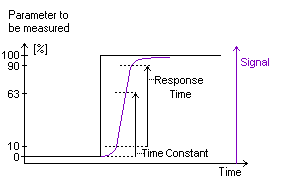
Rise Time
The Rise Time parameter (also referred to as Response) is a measure of how quickly the detector responds to a change in signal. The rise time is defined as the time it takes the detector's output signal to rise from 10% of its final value to 90% of its final value. The measured value is postulated to (in theory) directly jump from 0% to 100%.

The Rise Time (Response Time) is closely related to the Time Constant, as the following approximation shows:
Rise (Response) Time = 2.2 x Time Constant
A longer rise time has the following effects:
The short-term noise in the measurement signal is reduced.
The Signal-to-Noise Ratio improves up to a certain extent.
The peak width increases, thus deteriorating the separation of peaks that are close to each other.
The peak shape becomes asymmetric.
The peak maximum is shifted toward higher retention times.
The peak height is reduced.
![]() Note:
Note:
The rise time should be approximately 25% of the peak width at half height of the narrowest peak of interest.
For example, for a peak width of 5 seconds, calculate the rise time as: 1/4 (5 s) = 1.25 s. As it is not possible to set the rise time to 1.25 seconds, select the next fastest rise time. In this case, select 1 second.
If the rise time is considerably longer, the measured peak height is considerably lower than the real height. This decreases the maximum absorption at which the relationship between the measured absorption and the concentration is still linear.
![]() Tip:
Tip:
In the AD25, PDA, PDA-100, and PDA-3000 detectors, the rise time applies to both digital and analog output.
The UltiMate 3000 Series VWD-3x00 and the ICS-Series VWD detectors use the Time Constant parameter, not the Rise Time.